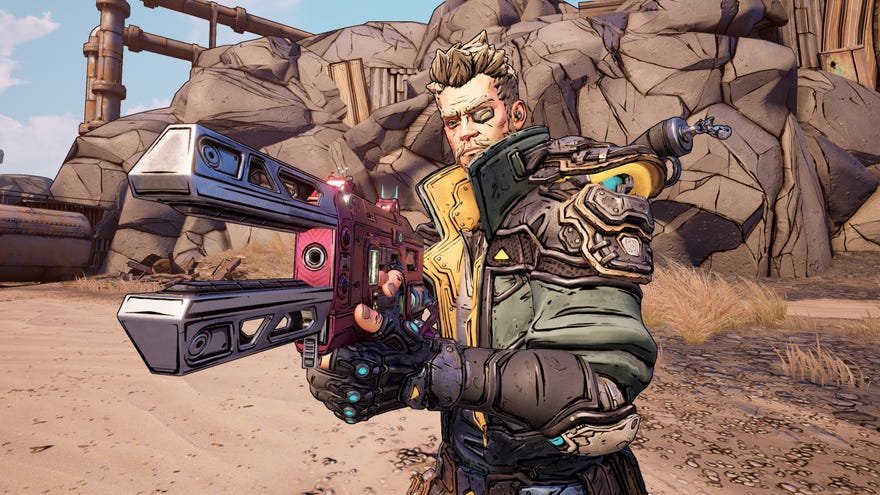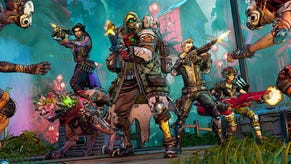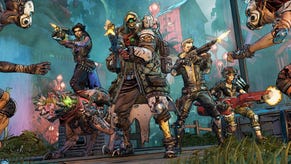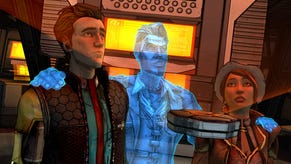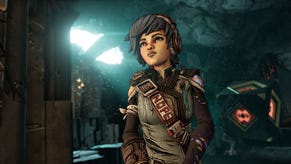Borderlands 3 performance: How to get the best settings
Plus DX12 vs DX11 and FidelityFX explained
Borderlands 3 may have been 2K's fastest selling game in the history of forever, but it sure hasn't been very quick about fixing its various performance problems over on PC. While last week's hotfix patch squashed a couple of performance-related issues, a proper solution for getting rid of things like stuttering and its DX12 load time problems has yet to materialise. Still, while we're waiting for Gearbox to finish putting together the game's next big patch, here's how to get the best Borderlands 3 performance for the time being.
Below you'll find the best settings for getting the most from Borderlands 3 on PC, and I've also been testing Borderlands 3's performance in both DX11 and its DX12 beta mode to see if there's actually any benefit to switching which version of DirectX it runs on. Last but not least, I've had a look at what AMD's image sharpening FidelityFX tech brings to the table as well.
Borderlands 3 PC requirements
The good news is that the PC requirements for Borderlands 3 are actually fairly low. As you can see from the specs boxes below, the minimum PC requirements include graphics cards that are at least eight years old right now, so even slightly ageing PCs should be able to get the game up and running at a reasonable speed.
Minimum PC requirements:
CPU: AMD FX-8350 / Intel Core i5-3570
RAM: 6GB
GPU: AMD Radeon HD 7970 (2GB) / Nvidia GeForce GTX 680 (2GB)
OS: Windows 7-10
Recommended PC requirements:
CPU: AMD Ryzen 5 2600 / Intel Core i7-4770
RAM: 16GB
GPU: AMD Radeon RX 590 / Nvidia GeForce GTX 1060 (6GB)
OS: Windows 7-10
Borderlands 3 performance: How to get the best settings
If you're here trying to find a fix for Borderlands 3's stuttering problems, then you should head over to our dedicated Borderlands 3 lag & stuttering fix guide. If you're here trying to get the best frame rates and the best performance, read on.
In the Advanced tab of Borderlands 3's Visuals menu, you'll find six different graphics presets: Very Low, Low, Medium, High, Ultra and Badass. That gives us quite a bit of room to play with when it comes to getting the best settings for Borderlands 3, especially when it comes to getting it running on lower-end PCs. Sure, it may not look particularly pretty, but if even my old AMD Radeon R9 270 card can manage an average of 50fps on Very Low at 1920x1080, then older HD 7000 series cards should definitely be able to cope with the game as long as you lower the resolution slightly.
I should also point out that, at the other end of the graphics settings scale, there isn't actually that much difference between Ultra and Badass. In fact, save for two settings (Volumetric Fog, which controls how much fog there is in a scene, and Screen Space Reflections, which is all to do with the quality of the game's reflections), they're both exactly the same. The only difference is that Volumetric Fog and Screen Space Reflections are simply set to High on Ultra, whereas Badass bumps them up to Ultra like everything else. As such, aiming for Badass isn't necessarily the be all and end all for those looking to get the best performance - as you can see from the images below (click to expand).






Unsurprisingly, Very Low is really quite ugly. Your guns and stuff look fine, but the wider environment has no anti-aliasing and no other special effects to speak of. Textures look muddy, and text - such as that Children of the Vault sign - is very low res.
Low, on the other hand, is already a lot sharper and more defined - mostly because it incorporates some nice Medium settings into its default profile, such as Terrain Detail and Shadows. It still doesn't have extra effects such as Volumetric Fog or Screen Space Reflections, but it's really not a bad starting point for lower-end GPUs.
Medium, meanwhile, adds a lot more detail into the scene, such as the graffiti on your hideout. This also has a couple of High settings, such as Material Complexity and Texture Streaming (which controls how quickly your PC's able to load in textures), and but keeps everything else on Medium, including Volumetric Fog and Screen Space Reflections.
High is pretty standard. As you'd probably expect, almost every option is set to High in this case, but it's also the first graphics preset that switches over to Temporal anti-aliasing instead of the lower-end FX anti-aliasing. It's also the first preset to have AMD's FidelityFX tech switched on by default.
Ultra, as stated above, is also pretty standard, bumping everything up to Ultra except Volumetric Fog and Screen Space Reflections, while Badass bumps those remaining two settings up to Ultra. It's also worth noting, however, that you're forced to have Object Motion Blur switched on when playing on Ultra or Badass, as this option becomes greyed out once you go above High.
As for how those settings translate into actual performance, here are the benchmark results I obtained with my PowerColour Radeon RX 580 (8GB) graphics card at 1920x1080, which is just under the recommended PC requirements for Borderlands 3 but well within its minimum requirements (and, in my eyes, is still one of the best graphics cards you can buy today for solid 1080p gaming).
| Very Low | Low | Medium | High | Ultra | Badass | |
|---|---|---|---|---|---|---|
| AMD Radeon RX 580 | 106.0fps | 95.3fps | 79.1fps | 50.3fps | 41.5fps | 38.8fps |
The biggest gulf, as you can see, is between Medium and High where performance almost halves as it tries to deal with Borderlands 3's higher-end graphics settings. I should note, it's still a heartening picture for anyone whose graphics card doesn't meet the recommended requirements for Borderlands 3, as an average of 80-odd fps on Medium at 1080p definitely isn't something to be sniffed at.
Still, for those desperate to get a smooth average of 60fps on the highest graphics settings possible, one of the best ways to do that is to turn off Volumetric Fog. This bumped up my RX 580's High average to a lovely 60.86fps when I re-ran the benchmark for a second time, and even brought its Ultra average up to 46.12fps. No other individual game setting has this much of an impact in Borderlands 3, so this is definitely my go-to solution for anyone struggling with their game's frame rate.

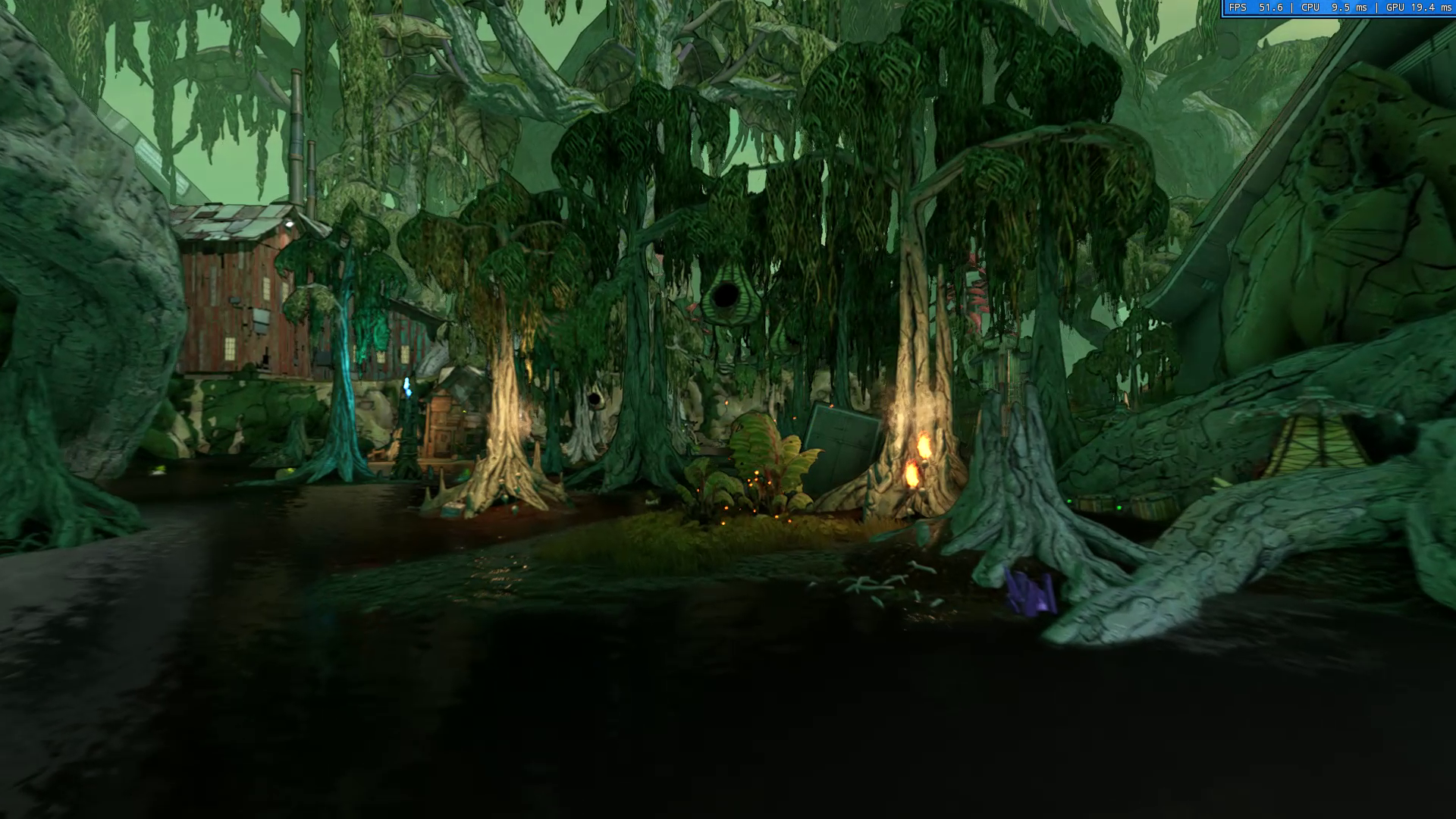
Other settings that made a teensy bit of difference include reducing the Material Complexity and Draw Distance options, but even switching from High to Low on both these settings only clawed back an extra couple of frames when I re-ran the game's internal benchmarking tool, so you're likely going to have to combine this with switching off other settings if you want to give your frame rate more of a boost.
If you're still struggling, you can take advantage of the game's Resolution Scale feature, which can be found in the Basic tab of the Visuals menu, but I wouldn't recommend it. Normally, this setting can be really helpful when it comes to taking some of the load off your GPU, as it effectively lowers the in-game resolution a bit while upscaling it to your chosen resolution, such as 1920x1080 or 2560x1440.
However, the Resolution Scale option in Borderlands 3 is pretty rigid compared to other resolution scaling features I've seen in other games, as it currently only lets you choose between 50% and 75%. If you're targeting 1920x1080, for example, that means it will render the game at either 960x540 or 1440x810, which really doesn't look very good in the flesh. Yes, running the game at 75% of 1920x1080 on Ultra brought my average frame rate up to 49.49fps in the game's benchmarking tool, but when running it at 100% of the sharper, more general resolution option of 1600x900 on Ultra still gets me an average of 46.35fps, I don't think it's really worth bothering with.
Borderlands 3 performance: DX12 vs DX11
All of the results so far were using the game's stable DX11 (or DirectX 11) mode. However, the game also has support for DX12, albeit in a so-called 'beta' version right now.
If you've tried running the game in DX12, you've probably been greeted by a five-minute load loading screen running at what looks to be a single digit frame rate (or just a single frame, full stop). At the moment, there's no way to fix this unfortunately, but if you persist the game will eventually load like normal and run perfectly fine. Well, almost.
Performance-wise, I actually found Borderlands 3 ran worse in DX12 than it did in DX11 - or at least it did on higher quality settings. Once I got down to Medium or below, DX12 produced some pretty juicy performance boosts. See the graph below for a full set of results from my RX 580.
| Very Low | Low | Medium | High | Ultra | Badass | |
|---|---|---|---|---|---|---|
| AMD Radeon RX 580 (DX11) | 106.0fps | 95.3fps | 79.1fps | 50.3fps | 41.5fps | 38.8fps |
| AMD Radeon RX 580 (DX12) | 115.0fps | 104.3fps | 83.6fps | 49.1fps | 40.4fps | 37.1fps |
In-game, however, DX12 was a bit of a horror show. Below are just some of the bugs and visual defects I encountered while playing Borderlands 3 in DX12, including noticeable chunks of the screen just going black for no reason, and lots of little flashing lights along the bottom of the HUD (which would flash like burning sun spots if I turned the camera the wrong way). There were also times when I was forced to navigate its settings menu using only my mouse because pressing Enter on my keyboard just made it go into windowed mode where it flat out refused to open up the Options screen.

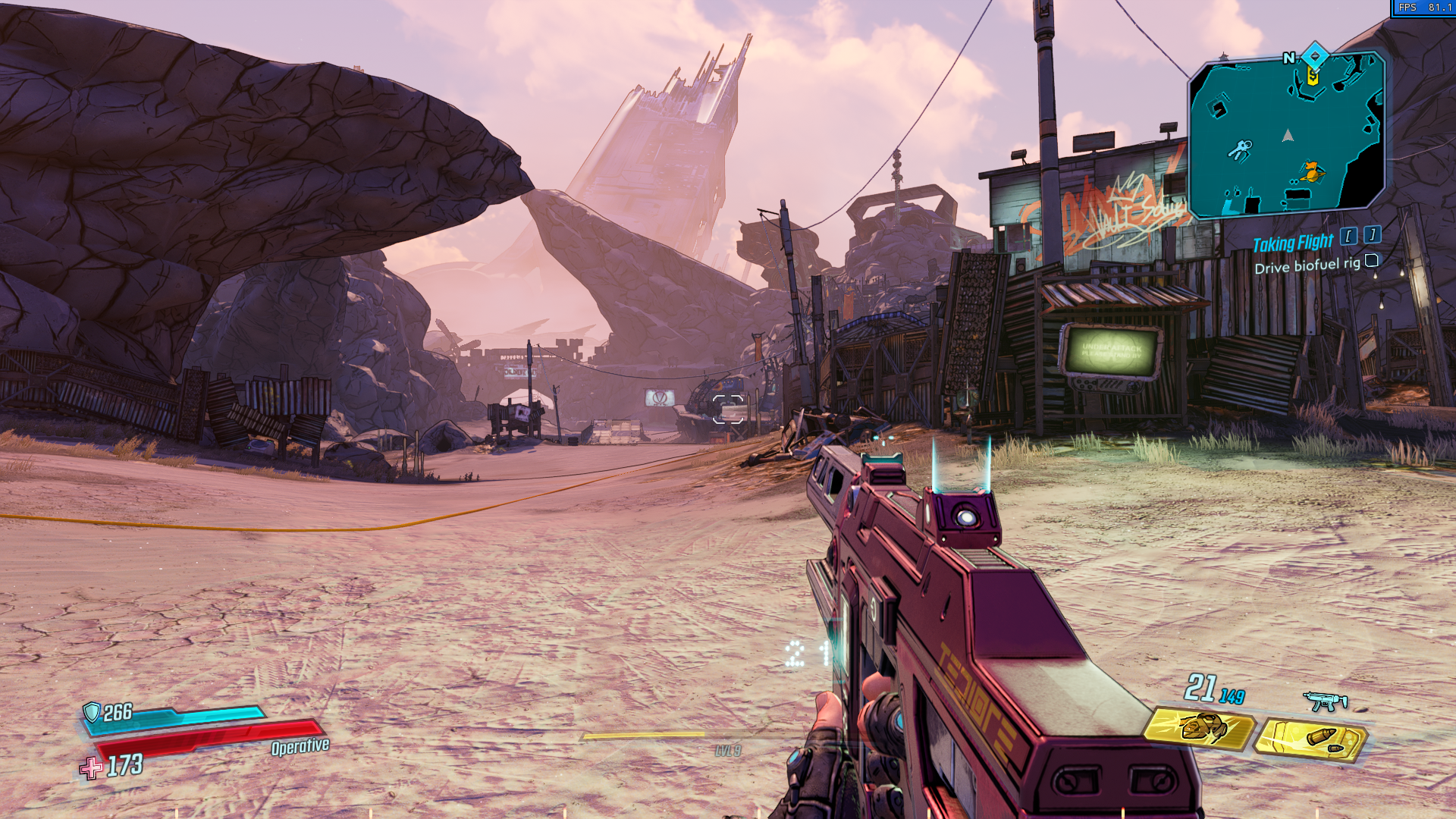
As a result, I really don't think it's worth trying to play Borderlands 3 in DX12 right now, especially when you've got to put up with its appalling load times, too. Instead, stick to DX11 where it's nice and stable and you'll have a much better time with it.
Borderlands 3 performance: AMD FidelityFX explained
Finally, you may have noticed there's a FidelityFX setting in Borderlands 3, which is one of AMD's new open source image sharpening features they unveiled alongside their new RX 5000 Navi GPUs. Since it's open source, it actually also works on Nvidia cards as well, so you don't even need an AMD card to take advantage of it.
Before you get too excited, though, you'll quickly see that any such "image sharpening" it provides is pretty minimal. According to AMD's website, it works by effectively combining lots of effects into a smaller number of shaders in order to reduce the load on your GPU, but I really had to squint and get right up close to my monitor screen to make out any discernible differences here, and even then I had a hard time spotting them.






There are some very tiny differences if you really look for them. In the first set of images with the Outrunner, for example, the detail of the rock texture behind it is ever so slightly sharper with FidelityFX turned on than it is turned off. There's also a marginally grittier effect to some of the rusted paint work on the Outrunner itself, too, but again, you really have to look for it.
The same goes for the rock textures in the second pair of images, too. The hive itself is pretty much identical (at least as far as my eyes are able to tell, at least), but the darker spots on the rock beside it are definitely sharper if you flick between the two images.
The third set of images, however, are even more difficult to tell apart. Yes, the Children of the Vault text in the very back of the image is a fraction sharper with FidelityFX switched on, as is the graffiti on the right hand side next to the mini map, but good grief it's so miniscule that I'd barely even notice anything was going of if I wasn't studying lots of different screenshots with a fine toothcomb.
The good news, at least, is that turning it on has zero effect on your PC's performance. When I tested it with AMD's Radeon RX 5700 XT, for example, it managed an average of 72.5fps on Badass at 1080p with FidelityFX turned off, and an average of 72.8fps with FidelityFX turned on, so you may as well have it enabled even if the effect itself is barely noticeable in motion.
I'll be updating this Borderlands 3 performance guide with more info as soon as Gearbox get round to releasing their next big patch for the game, but hopefully the tips I've described above will help you get the best performance you can from it for the time being.
Of course, if you'd like more info on the best ways to play Borderlands 3, then check out our guides team's in-depth Borderlands 3 characters & skill trees guide as well as their Borderlands 3 weapons guide. They've got everything you need to know about the best builds for its four main characters, as well as all the Borderlands 3 Shift Codes & VIP Codes you could possibly want.
